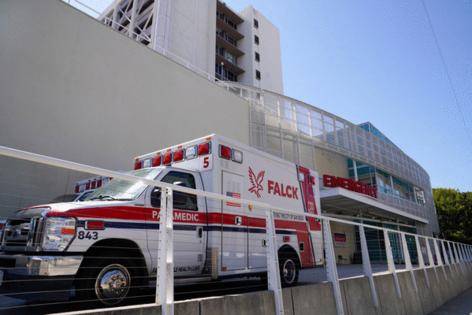San Diego's partial takeover of ambulance service is shrinking response times
Published in News & Features
SAN DIEGO — Ambulance response times in San Diego have improved significantly since the city switched to a new partnership where private ambulances transport patients while the city handles deployment, staffing and billing.
City officials revealed response-time comparisons Friday for the first time since the October 2023 launch of the new partnership, which has also generated millions in profits the city is using to address a budget crisis.
Under the new partnership, the city is failing much less often to meet its response-time standard of arriving at emergencies within 10 minutes at least 90% of the time.
But the boost in response times may be coming at a cost to the city’s paramedics and emergency medical technicians, who say they feel overworked and want the city to add more ambulances.
“The real issue here is workload and it’s concerning for us,” said Tony Sorci, leader of the labor union that represents city ambulance workers. “My people are getting crushed.”
The city increased the number of hours its ambulances are in service daily by 48 in January — an increase from 1,008 hours per day to 1,056 hours per day — to cope with a steady increase in call volume and ambulance transports.
But Sorci said there are hundreds of unstaffed shifts, especially at night. And he said some ambulances are out of service hundreds of hours per month when they are scheduled to be in service.
Sorci lobbied the City Council’s Public Safety Committee on Friday to accelerate a city plan to put its ambulance service back out to bid for private ambulance companies in coming months.
That process, called a request for proposals, is expected to include the possibility of the city bringing ambulance service in-house — meaning ambulance workers would be city employees and no longer work for private operators.
Fire Chief Robert Logan said in May that he and Mayor Todd Gloria have been discussing that possibility, but that it would likely happen slowly.
That likely means some sort of hybrid approach where city ambulance crews handle low-level emergencies, called basic life support, while private ambulances continue to handle more life-threatening emergencies, called advanced life support.
If the hybrid approach is successful, the city could move incrementally toward fully handling all ambulance service in-house.
But city officials have stressed that they are still evaluating all options and aren’t yet close to a decision on which course to pursue.
The first step toward bringing ambulance service in-house was the new partnership, which took staffing and deployment away from the private operators but left the workers as their employees.
The partnership is with Falck USA and American Medical Response. On Friday, a Falck official said some credit for the response times should go to his company for stabilizing response times before the partnership kicked in.
“That early work help stabilized the system and created the foundation for what we now see,” said John Goward, Falck’s local managing director.
The city released comparison response-time stats Friday for the year before the partnership and the first year of the partnership, broken down by three-month periods called quarters.
The comparison shows 16 failures out of a potential 45 during the first quarter of the year before the partnership, compared with two failures out of a potential 45 during the first quarter of the partnership.
In the second quarter, there were 30 failures during the year before the partnership and 14 failures during the first year of the partnership. In the third quarter, there were six failures before the partnership and two failures during the partnership.
In the eight months since the comparison period, city officials say response times have remained steady.
City officials credit the improvement to a consortium of managers, emergency workers and labor leaders and to changes in how city ambulances are dispatched.
That means fewer breaks for workers and other changes that Sorci cited as potential problems.
“The numbers don’t reflect the reality because many of the issues — the impediments — are buried in the unstaffed hours and out-of-service hours,” he said.
The partnership is generating about $11 million a year in profit for the city. The city used $9.3 million in profits to help balance the budget for the fiscal year that ends Tuesday and plans to use $11.5 million in profits to balance the budget for the fiscal year that starts Wednesday.
A key to the partnership’s profitability is a 2023 state law that boosts reimbursement rates on ambulance transports when government agencies handle deployment instead of private contractors.
©2025 The San Diego Union-Tribune. Visit sandiegouniontribune.com. Distributed by Tribune Content Agency, LLC.







Comments